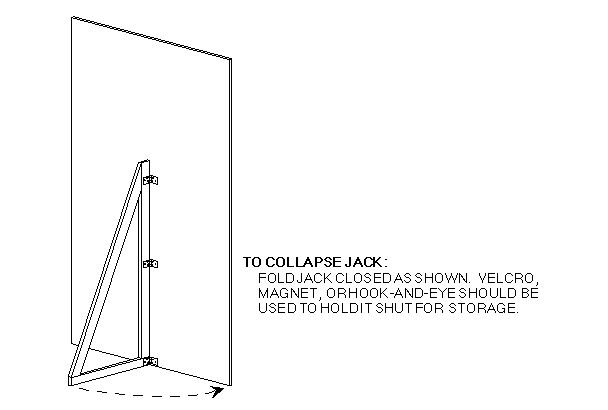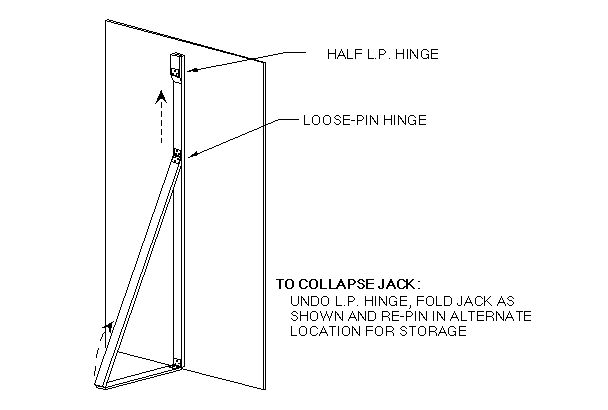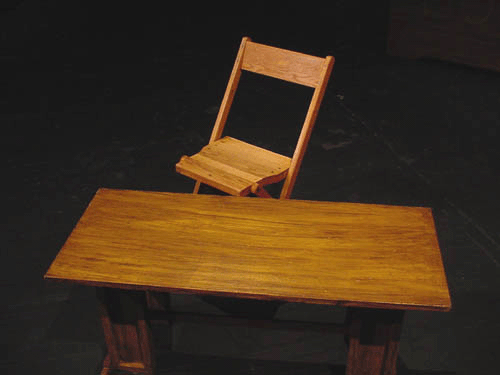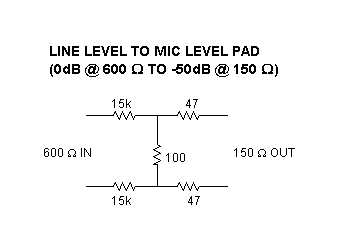Scenic Construction Tips | Scene Painting Tips | Stage Lighting Tips | Sound Production Tips | Home
Refer to my home page for a disclaimer before implementing any of these tips and subsequently hating me.
Tools & Materials
- John's favorite drill bit sizes
- 25/64" (fits in 3/8" chuck, 3/8" bolt pulls out easier)
- 5/32" (perfect size for #8 sheet metal screw going into 16-18 ga. steel)
- 7/64" (when pilot hole in pine/spruce for normal drywall screws is necessary)
Platforms
- When laying out a platform deck which requires seams in the lid, seams parallel to the audience are less visible than perpendicular seams.
Bracing Scenery
- This simple jack folds open/shut about as quickly as any ever designed.
To prevent the scenery from falling forward, either provide hardware to attach
to floor, or add weight to the jack. (The weight can be anything from a professionally
made stage weight to a #10 coffee can full of sand hanging from the hypotenuse
of the jack.)

- A similar jack which works well when the scenery is quite thin involves
the use of a loose-pin hinge to hold the jack parts in one of two possible
locations. This method takes longer to construct, requires more wood, and
takes up more space when collapsed than the previous method, but it looks
a lot cooler.

Prop Booze Formulas
- To match Dewar's "White Label" Blended Scotch Whiskey,
mix :
- 2 tsp. Lipton Powdered Iced Tea Mix
- 2 cups Water
- 2 drops McCormick Yellow Food Coloring
- To match E & J Brandy, mix:
- 4 tsp. Lipton Powdered Iced Tea Mix
- 2 cups Water
- 4 drops McCormick Yellow Food Coloring
- To match Taylor Golden Sherry, mix:
- 8 cups Water
- 6 drops McCormick Yellow Food Coloring
- 4 drops McCormick Red Food Coloring
- 1 drop McCormick Blue Food Coloring
Color Mixing with Food Dyes
The McCormick food dye people offered the following recipies for mixing their four basic colors into more exotic ones at a local grocery store:
- Watermelon = 25 Red : 2 Blue
- Fuchsia = 18 Red : 2 Blue
- Rasberry = 14 Red : 6 Blue
- Plum = 10 Red : 4 Blue
- Cantaloupe = 24 Yellow : 2 Red
- Maize = 24 Yellow : 1 Red
- Lime = 24 Yellow : 4 Green
- Orange Sunset = 17 Yellow : 3 Red
- Jungle Green = 14 Green : 6 Yellow
- Jade = 17 Green : 3 Blue
- Teal = 15 Green : 5 Blue
- Spearamint = 12 Green : 6 Yellow : 2 Blue
- Grape = 17 Blue : 3 Red
- Purple = 15 Blue : 5 Red
How to Know if a Door is Left-Handed or Right-Handed
- When facing a door that needs to be pushed away from you: hinges on the left = left-handed; hinges on the right = right-handed
Scenic Construction Tips | Scene Painting Tips | Stage Lighting Tips | Sound Production Tips | Home
Refer to my home page for a disclaimer before implementing any of these tips and subsequently hating me.
Recipes
- In our tribute to 1000 years of theatrical farce, we created a false upstage
wall almost 20' downstage of the actual one. We painted it to match the fairly
typical (perhaps slightly "orangey") existing bricks of our theater walls.
It was realistic enough that a tour of foreign students/parents prompted the
following question, "Are all American theaters this shallow?" Needless to
say, they were quite suprised when they were shown that the brick wall in
question was a piece of fabric. The ratio was as follows (all paints were
Rosco "Off Broadway" brand):
- Brick Base #1= 9 parts "Orange" : 1 part "Black" (tint w/ "white" for
highlight)
- Brick Base #2= 9 parts "Burnt Sienna" : 1 part "White" (shade w/ "black"
for shadow)
- Mortar= 6 parts "White" : 1 part "Black" : 1 part "Yellow Ochre"
- Dark Glaze (for variation of occasional bricks)= Watered down "Raw Umber"
These colors will work with a variety of methods of scene painting for bricks
by adjusting the amount of water. Our painted bricks measured roughly 3" by
8" including the mortar lines which were approximately 1/2" wide.
- For a production of G.B.Shaw's Mrs. Warren's Profession, I was asked
to paint most of the furniture and set pieces in a natural wood-grain to match
two existing wooden folding chairs.
 |
(All paints Rosco "Off Broadway")
- Wood Base #1= 1 part Yellow Ochre : 1 part White
- Wood Base #2= Raw Sienna
- Wood Wash= 1 part Burnt Umber : 2 parts Water
- (wiped off with newspaper to mimic wood grain)
- Glaze= 1 part Gloss : 1 part Water
|
- To paint a ground row or other element needing to match our light blue skydrop,
we mix Rosco's "Off Broadway" paints in the following ratio:
- 2 parts Sky Blue : 16 parts White : 1/2 ~ 1 part Orange (adjust to match
actual fabric)
- In his book Designing and Painting for the Theatre, Lynn Pecktal
offers a recipe for starching a drop which uses a product called "gloss starch".
Wanting to use his recipe on one of our previous productions, we tried to
get our hands on gloss starch locally and failed. Not sure where else to look,
we decided to phone the Argo corn starch folks and see if they could help
out. Best Foods/CPC International (the makers of Argo starches) sure gave
us the impression that gloss starch was something that died with the disco
era because they didn't have any idea what Mr. Pecktal was talkin' about.
They suggested the following method in place:
- Mix 1/3 cup Argo corn starch with 1/2 cup cold water
- Add boiling water to the mix:
- 2 qts. for a heavy solution
- 4 qts. for a medium solution
- 6 qts. for a light solution
- Allow to cool before using
Pecktal recommends 1 gallon of starch solution per 100 sq. feet of drop to
be sized. This is applied with a garden sprayer and a clean brush or broom
using the technique described in his book. Note that analine dye can be added
to the solution as an early base color and to aid in seeing what has and hasn't
been done.
However, the saga continues: in January of 2006, Nancy Orr, the Scenic
Charge at Showman Fabricators in New York happened upon this very page here
at the world's most unnecessary web site, and had this to say about the above
information, "We still use Argo Gloss Laundry Starch prepping our drops
up, and I buy it by the case as we use large amounts of it. It is still the
standard for New York scene shops, especially when painting translucencies."
This prompted our crack team of investigative reporters to dig in and do some
serious research. However, since these people are nothing more than figments
of my imagination, they didn't turn anything up. Hence, I was forced me to
make a few calls of my own. It turns out that Ms. Orr is absolutely correct.
The starch-in-question is readily available from scenic supply vendors such
as Rose Brand of New York/Los Angeles. Currently, they list it as "Argo
Starch" (omitting the word "gloss"), but a representative from
Rose Brand confirmed for me that this is the right stuff and is definitely
not the corn starch found at every grocery store on the planet. Curiously,
I asked if it was possible that they had temporarily stopped carrying this
product at some time in the recent past, but they checked and Rose Brand has
listed it in every catalog since at least 1996 (the oldest one they could
find).
So, this pretty much being a non-issue, I leave the corn starch recipe above
just in case anyone's ever painting a drop in some nook of the world where
grocery stores exist and mail-order delivery doesn't. The mystery of why the
Argo people claim to never have heard of a product that they're still making
remains unsolved...
Sealing the Floor
- In productions of "Charlotte's Web" and "Suddenly Last Summer" (January 1997) we used Rosco Acrylic Flat mixed 2 parts water to 1 part sealant. Mopping had no effect on paint treatments underneath and sealant was virtually invisible.
Flame Treatments
- For the production of "Savage/Love" (February 1997) a representative from Rosco Labs warned not to use any of the pre-mixed flame retardancy products (RoscoFlamex C26, RoscoFlamex S33, or RoscoFlamex W40) for treating exposed carpet padding (soft foam). He approved however, paint additive RoscoFlamex P50 mixed in acrylic flat (even diluted 2 water:1 acrylic flat) but warned that we should dilute the "paint" first and then add the Flamex.
Shop Built Scene Painting Tools
- Many textbooks refer to something called a "lining tool", but
few give any detail. This is simply a straight edge, usually with an extension
handle to keep the scenic artist from having to bend over while painting objects
on the floor. This sentence is a link to a measured
drawing of a lining tool. Note that the long sides of the straight edge
are beveled. This is done so to prevent paint from bleeding under the tool.
To use the tool, make sure that the brush only comes in contact with the straight
edge at the wide part which is not in contact with the work piece.
Scenic Construction Tips | Scene Painting Tips | Stage Lighting Tips | Sound Production Tips | Home
Refer to my home page for a disclaimer before implementing any of these tips and subsequently hating me.
Never Memorize Anything You Can Look Up
- Label the frosted side of any "frost" gel to help insure that it will be placed in the unit with the frosted side facing out. Reversing the gel will impair its performance.
- NEMA Codes for Connectors I Care About
- 15a 125v Edison (normal household) = NEMA L5-15
- 20a 125v Twist-Lock (pin "bent" in) = NEMA L5-20
- 20a 125v 2P&G ("Pin") = no NEMA code
- DMX Termination
- According to the standard, connect 90-120 ohms (1/4 watt) across pins 2 and 3 of a 5-pin XLR connector
- For devices that use a 3-pin XLR, use pins 2 and 3 as well
Non-Dims Aren't Really All They're Cracked Up To Be
- In the 2006 Spring Newsletter from the Barbizon company, they offered this important tip: "Moving lights and other relay effects should never be plugged into dimmers. Even if a dimmer is parked at "Full" or if a dimmers is set to non-dim status, the nature of the current running through the dimmer can effect how moving lights, strobes and other effects operate. If effects are continually plugged into dimmers, the unit eventually could be harmed. For best results it is recommended to plug moving lights, strobes, and other effects into direct power such as a wall circuits, hot pockets, or relay modules."
A Recipe for Artificial Rippling Water Reflections
- For a production in the spring of 2016, I created the look of reflections from rippling water using gobo rotators and glass and metal gobos. I used two 90° Source 4's (with the Source 4wrd LED retrofit lamps, though there was no difference when tested with conventional HPL575 lamps). This was mostly for coverage (I had a very short throw and relative wide stage image to fill), but also, the overlap of the two fixtures helped to confuse the eye's natural attempt to discover patterns from rotating repitition.
- Both rotators were Apollo Smart Move DMX's
- One rotator had Rosco Image Glass #33619 "Ripples" in the front slot and Rosco Image Glass #33602 "Plume" in the back slot
- The other rotator had Rosco Image Glass #33617 "Hammered" in the front slot and Rosco Image Glass #33620 "Ice" in the back slot
- Rosco glass gobos don't fit the opening of the Apollo Smart Move DMX (diameter is too large), so some futzing was necessary
- The choice of mixing and matching, rather than duplicating, was based on existing stock and budget constraints
- One pair worked better than the other, but I didn't make note of which
- Metal gobos were placed in the gobo slot with the "parallel" lines oriented horizontally
- One fixture had Rosco #77833 "Water 1"
- The other fixture had Rosco #79665 "Reflected Water 4"
- Sadly, I didn't record wich gobo was used with which rotator pair
- Again, the non-duplicative gobos were pulled from stock and purchase was not an option
- I still prefer the look and results of the classic fan next to a dish of water on a mirror effect, but for this show, I needed the ripple reflections to come from the downstage center, edge-of-the-stage, footlight position with no place to hide any apparatus. After a week of experiments, I went with the artificial solution instead.
Scenic Construction Tips | Scene Painting Tips | Stage Lighting Tips | Sound Production Tips | Home
Refer to my home page for a disclaimer before implementing any of these tips and subsequently hating me.
Useless Sound Bytes (pun courtesy of Jill Huntsberger)
- The speed of sound is 1,130 feet per second. Reciprocally, sound travels 0.0008849 seconds per foot. For instance, it takes sound .06017 seconds to travel 68 ft. It is 68'-8" from the upstage wall of Strider Theater to the back wall of the house. This is noticeably perceptible to someone sitting in the back row comparing the upstage speakers to the house rear speakers (each receiving an identical signal).
Fun Things To Do With Your Soldering Iron When You're Bored
- Next time you absolutely have to plug a tape deck or other line level device into the mic input on your channel-deficient mixer, make yourself this handy converter...

MIDI Machine Control Commands I Really Like
Converted from hex
- Stop, Play, Deferred Play, Fast Forward, Rewind, Record, Record Exit, etc...
240 127 [device ID] 6 [p1] 247
...where p1 is set to...
- Stop
- Play
- Deferred Play (waits to play until location is found)
- Fast Forward
- Rewind
- Record Strobe (starts recording from play or stop)
- Record Exit (stops recording, but does not stop play)
- Locate Time (target)
240 127 [device ID] 6 68 6 1 [hours] [minutes] [seconds] [frames] [sub-frames] 247
- Locate Point 1-8 (MCP)
240 127 [device ID] 6 68 2 0 [p1] 247
...where for location...
- p1 is set to 8
- p1 is set to 9
- p1 is set to 10
- p1 is set to 11
- p1 is set to 12
- p1 is set to 13
- p1 is set to 14
- p1 is set to 15
Back to Home Page of John D. Ervin's THEATRICAL DESIGN/PRODUCTION STUFF





